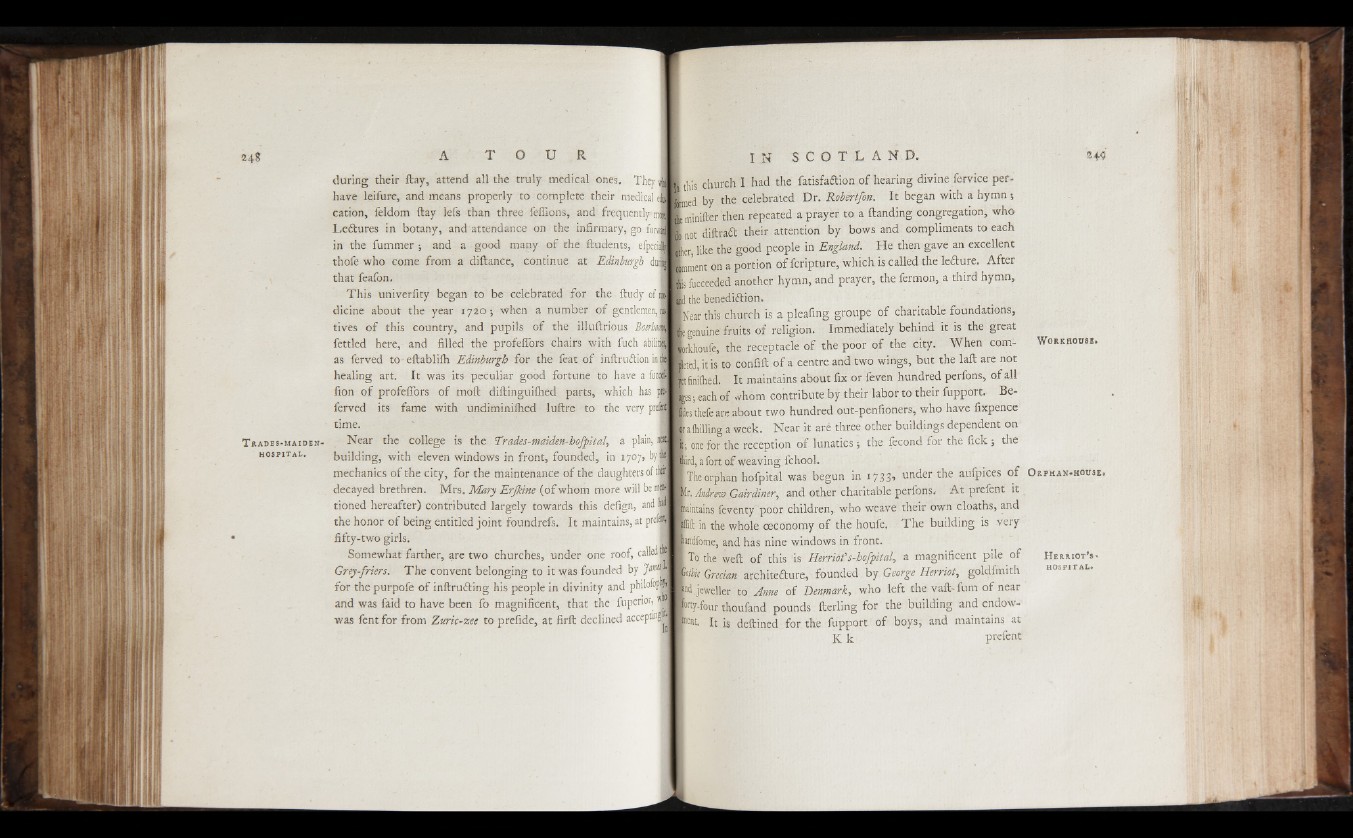
l i l i l í
T r a d e s - m a i d e n -
h o s p i t a l .
during their itay, attend all the truly medical ones. T h ey 4 I ^ church I had the fatisfaftion of hearing divine fervice per Jmed by the celebrated Dr. Robert/on. It began with a hymn •,
have leifure, and means properly to complete their medical ej
cation, feldom itay lefs than three f e f fio n s , and fr e q u e n tly mi
Leftures in botany, and attendance on the infirmary, g o ford
in the fummer ; and a good many of the ft u d e n t s , efpecij
thole who come from a diftance, continue at Edinburgh dutj
that feafon.
This univerfity began to be celebrated for the ftu d y of
dicine about the year 1720; when a number of gen tlem en ,«
tives of this country, and pupils of the illuftrious Boerhai
fettled here, and filled the profelfors chairs with fu c h abiliti
as ferved to - e f t a b l i i h Edinburgh for the feat of in ftru ftio n in tjitl
healing art. It was its peculiar good fortune to h a v e a luctfl
fion of profelfors of molt diftinguilhed parts, which has p®
ferved its fame with undiminilhed luftre to the v e ry p H
time.
Near the college is the Trades-maiden-hofpital, a plain,
building, with eleven windows in front, founded, in 17071 byti
mechanics of the city, for the maintenance of the d a u g h te r s of tlw
decayed brethren. Mrs. Mary Erjkine (of whom more will beH
tioned hereafter) contributed largely towards this d e fig n , and M
the honor of being entitled joint foundrefs. It m a in ta in s , at preW
fifty-two girls.
Somewhat farther, are two churches, under one roof, ca lled *
Grey-friers. The convent belonging to it was founded b y Jemm
for the purpofe of inftrufting his people in divinity and p h ilo fH
and was faid to have been fo magnificent, that the fuperiorj
was fent for from Zuric-zee to prefide, at firil declined accept
fkminifter then repeated a prayer to a Handing congregation, who
[do not diftraft their attention by bows and compliments to each Tier, like the good people in England. He then gave an excellent
Lment on a portion of fcripture, which is called the lefture. After
| s fUcceeded another hymn, and prayer, the. fermon, a third hymn,
Jl the benediftion.
¡Near this church is a pleafing groupe of charitable foundations, 4 trenuine fruits of religion. Immediately behind it is the great
[rkhoufe, the receptacle of the poor of the city. When com- W o r k h o u s e .
feted, it is to confift of a centre and two wings, but the laft are not
¡et finiihed. It maintains about fix or feven hundred perfons, of all
; each of whom contribute by their labor to their fupport. Be-
Bes thefe are about two hundred out-penfioners, who have fixpence 4 a (hilling a week. Near it aré three other buildings dependent on
one for the reception of lunatics ; the fecond for the fick ; the
jird, a fort of weaving fchool.
The orphan hofpital was begun in 1733’ under the aufpices of O r p h a n - h o u s e .
|k. Andrew Gairdiner, and other charitable perfons. At prefent it
laintains feventy^poor children, who weave their own cloaths, and
in the whole oeconomy of the houfe. The building is very
Mfome, and has nine windows in front.
To the weft of this 'is Herriot's-hofpital, a magnificent pile of
'ttUc Grecian architecture, founded by George Herriot, goldfmith
M. jeweller to Anne of Denmark, who left the vait-fum of near
f>fty-four thoufand pounds fterling for the building and endow-
W. It is deftined for the fupport of boys, and maintains at
K k prefent
H e r r io t ’s -
HO SP ITA L*